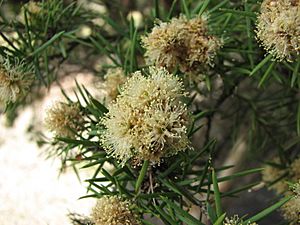Melaleuca nodosa facts for kids
Quick facts for kids Prickly-leaved paperbark |
|
|---|---|
 |
|
| M. nodosa in Maranoa Gardens | |
| Scientific classification | |
| Genus: |
Melaleuca
|
| Species: |
nodosa
|
| Synonyms | |
|
Metrosideros nodosa Sol. ex Gaertn. |
|
Melaleuca nodosa, commonly known as the prickly-leaved paperbark, is a plant in the myrtle family, called Myrtaceae. It grows naturally only in eastern Australia. This plant can be a shrub or a small tree. It has narrow, sometimes needle-like leaves and many bright yellow flowers. These flowers can appear as early as April or as late as January.
Contents
About the Prickly-leaved Paperbark
What it Looks Like
The prickly-leaved paperbark is a shrub or small tree. It can grow up to about 10 m (30 ft) (33 feet) tall. It has thick bark that feels like paper.
Leaves and Bark
Its leaves are stiff and thin. They can be shaped like a line or almost round, like a needle. They are usually 10–40 mm (0.4–2 in) (0.4 to 1.6 inches) long. The leaves are also very narrow, about 0.5–1.5 mm (0.02–0.06 in) (0.02 to 0.06 inches) wide. Each leaf ends in a sharp point.
Flowers and Fruit
The flowers are white to yellow. They grow in thick clusters or short spikes at the ends of branches. New growth continues from these branches even after the flowers bloom. Sometimes, flowers also grow where the upper leaves meet the stem.
Each flower cluster can be up to 30 mm (1 in) (1.2 inches) wide. It holds up to 20 groups of flowers, with three flowers in each group. The petals are small, about 1.8–2.3 mm (0.07–0.09 in) (0.07 to 0.09 inches) long. They fall off as the flower gets older. Each flower has five groups of stamens (the parts that make pollen), with 7 to 10 stamens in each group.
This plant usually flowers from September to November. October is often when the most flowers appear. However, you might see flowers at other times of the year too. After flowering, the plant produces woody, cup-shaped capsules. These capsules are 3–5 mm (0.1–0.2 in) (0.12 to 0.2 inches) long and 2–3 mm (0.08–0.1 in) (0.08 to 0.12 inches) wide. They usually grow in tight, round clusters along the stems.

How it Got its Name
A German botanist named Joseph Gaertner first described this plant in 1788. He called it Metrosideros nodosa. Later, in 1797, James Edward Smith gave it its current scientific name, Melaleuca nodosa.
The second part of its name, nodosa, comes from a Latin word. Nodosus means "knotty" or "knobby." This name might refer to the shape of the fruit clusters, which often look like small knots.
Where it Grows
The prickly-leaved paperbark grows along the coast and on the high lands (tablelands) of Queensland and New South Wales in Australia. You can find it from the Blackdown Tableland National Park down to Campbelltown near Sydney.
It likes to grow in different types of soil. This includes sandy soils, clay soils, and soils from shale. It also grows in heathlands, which are open areas with low-growing plants. It can form thick groups of plants in these areas. Often, the places where it grows do not drain water very well.
Some other plants that grow near it in heathlands include the bracelet honey myrtle (Melaleuca armillaris), heath banksia (Banksia ericifolia), smooth-barked apple (Angophora costata), and red bloodwood (Corymbia gummifera). In woodlands, you might find it with scribbly gum (Eucalyptus sclerophylla), Parramatta red gum (E. parramattensis), narrow-leaved apple (Angophora bakeri), and white feather honeymyrtle (Melaleuca decora). If you see it growing in a wallum heathland, it might mean the soil there is a bit salty.
How it Helps Nature
Native bees, honeybees, and possibly beetles and flies help pollinate the flowers of Melaleuca nodosa. This means they carry pollen from one flower to another, helping the plant make seeds.
This plant is also a host for certain types of mistletoe. Mistletoe is a plant that grows on other plants. Some mistletoe species that grow on Melaleuca nodosa include Amyema congener, A. gaudichaudii, Dendrophthoe curvata, and D. vitellina.
Growing it Yourself
The prickly-leaved paperbark is quite easy to grow in gardens. It grows best in full sun and likes to have extra water. Even though it's not grown everywhere, it could be a good plant for making hedges. It can even grow well in areas where there is salt spray from the ocean.
Images for kids
-
M. nodosa growing near Karuah
-
M. nodosa in the Australian National Botanic Gardens






